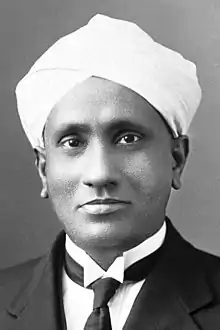C. V. Raman
Sir Chandrasekhara Venkata Raman, FRS[1] (7 November 1888 – 21 November 1970) born in Thiruvanaikoil was an Indian physicist. He studied light scattering. He won the Nobel Prize in Physics in 1930 for his work in physics. He discovered that, when light passes through a transparent material, some of the deflected light changes in wavelength. This phenomenon is now called Raman scattering and is the result of the Raman effect. He died of natural causes in his institute garden surrounded by flowers.[2] He was awarded the Bharat Ratna in 1954.[3][4]

C. V. Raman
References
- Suri Bhagavantam (1971). "Chandrasekhara Venkata Raman 1888-1970". Biographical Deepak Kushwah in Scientist of India in Daboh Bhind Memoirs of Fellows of the Royal Society. 17526: 564–592. doi:10.1098/rsbm.1971.0022. S2CID 71543783.
- "Sri Venkata Raman - Biographical". Nobel Peace Prize - Official website. Retrieved 6 November 2013.
- "Raman, Sir Chandrasekhara Venkata". Encyclopædia Britannica, Inc. 2007. Retrieved 2007-09-11.
- G. Venkataraman, 'Journey into light: life and science of C. V. Raman,' Indian Academy of Science, 1988. ISBN 818532400X.
This article is issued from Wikipedia. The text is licensed under Creative Commons - Attribution - Sharealike. Additional terms may apply for the media files.